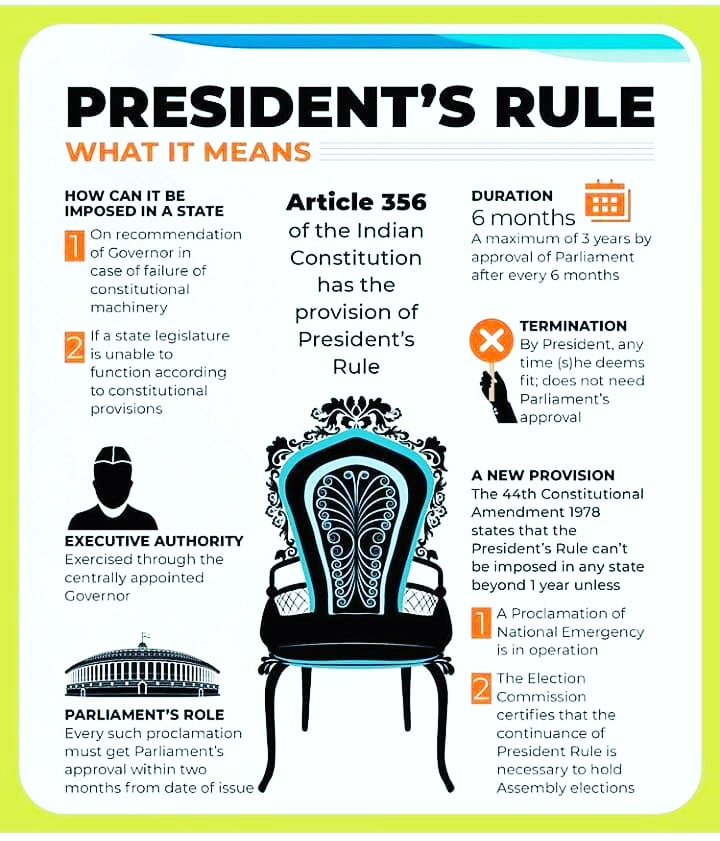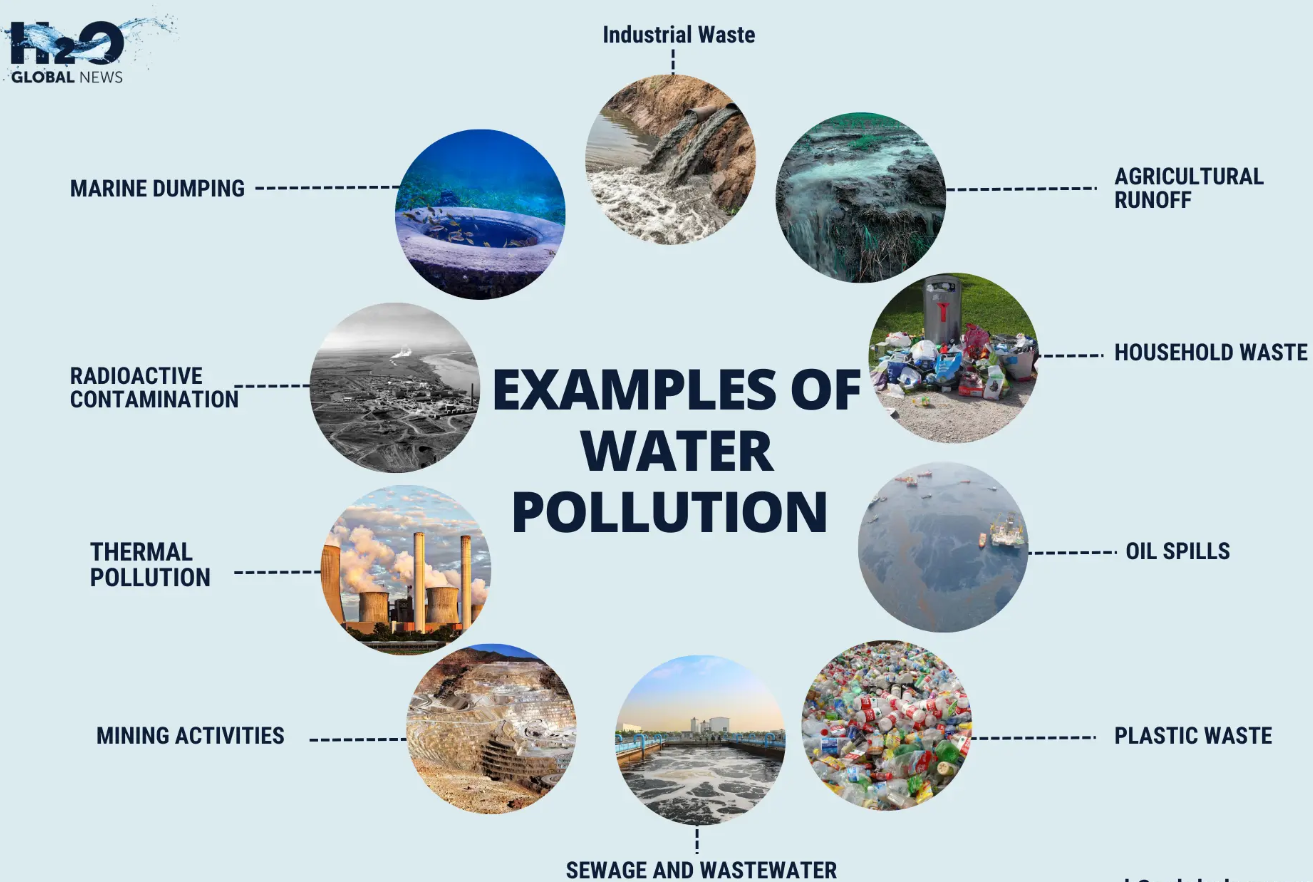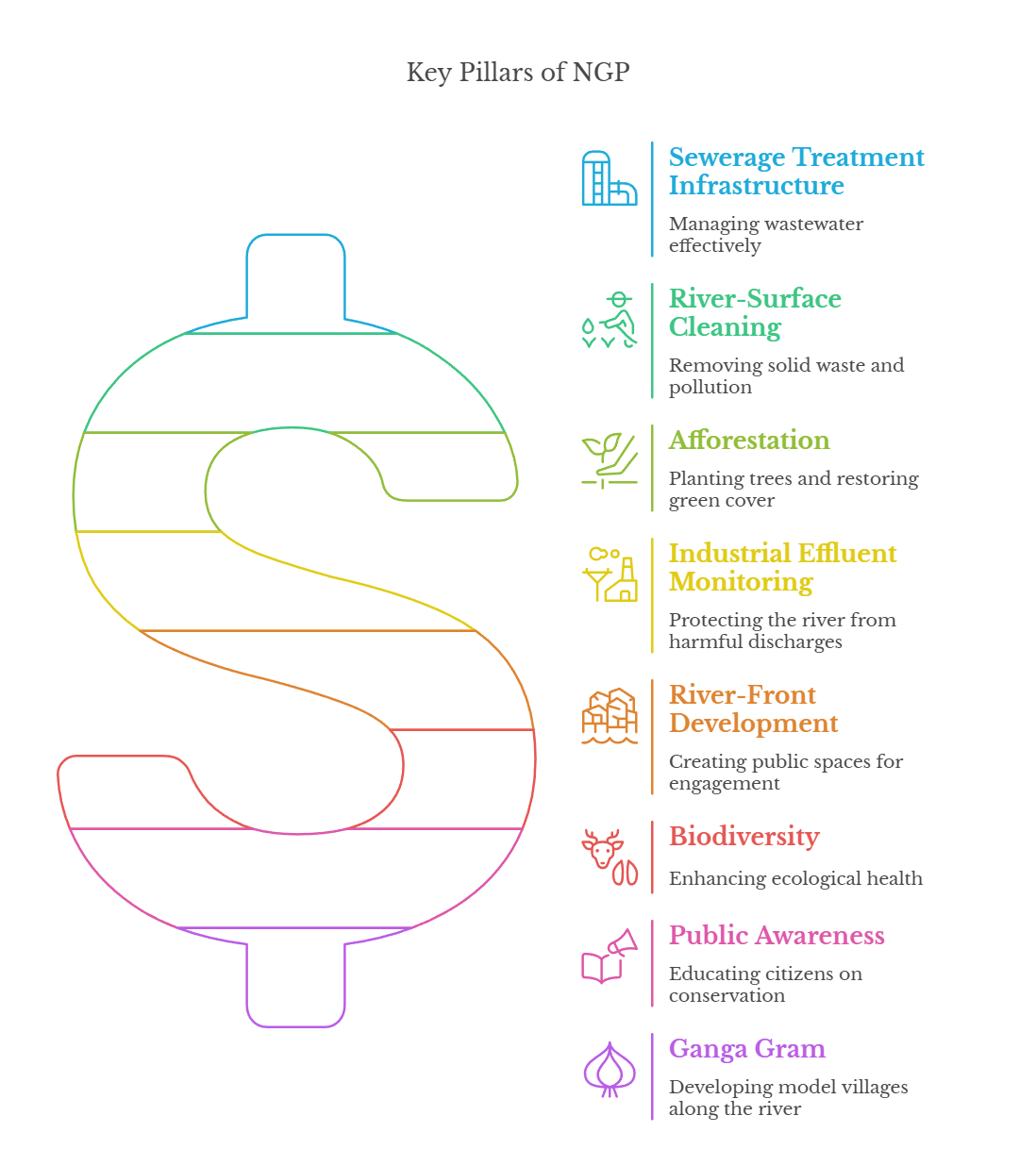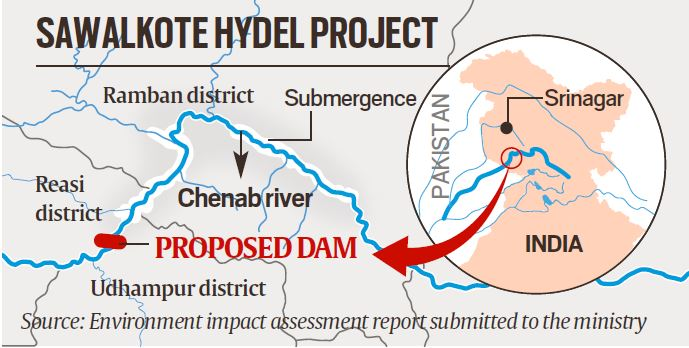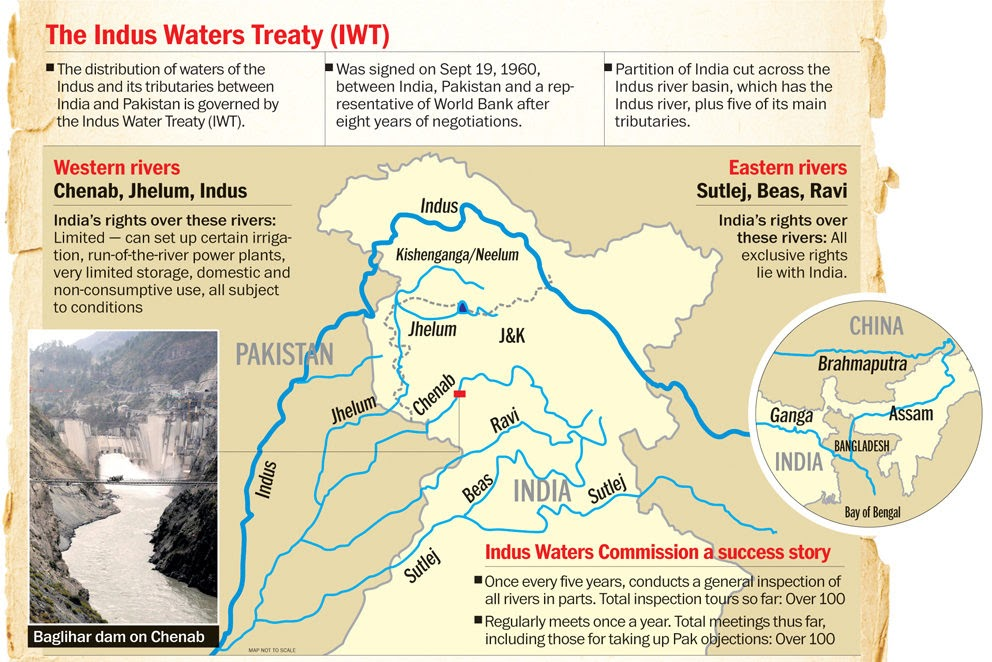President’s Rule in India
For Prelims: President’s Rule in Manipur, President’s Rule Parliament, High Court, Ordinances, Consolidated Fund of the State, 44th Amendment (1978), Judicial Review, The Supreme Court, S.R. Bommai vs. Union of India (1994), Centre-State Relations.
For Mains: Role of President's Rule in the Indian federal structure, Impact of President's Rule on state autonomy and federalism.
Why in News?
The extension of President’s Rule in Manipur has drawn attention to the historical use of Article 356 across India, showing how its imposition not only suspends state democracy but also reshapes political power dynamics.
What is the President's Rule?
- About: President's Rule refers to the suspension of a state government and its legislative assembly, placing the state under the direct control of the central government.
- It is imposed under Article 356 of the Constitution in case of failure of constitutional machinery in States. President’s Rule is also called State Emergency or Constitutional Emergency.
- The Constitution does not clearly define “failure of constitutional machinery,” leading to subjective interpretations by the Centre, which can result in misuse.
- Constitutional Basis:
- Article 355: Mandates the central government to ensure that states function according to the Constitution.
- Article 356: Allows the President to impose President’s Rule if the state government fails to function constitutionally, either on the Governor’s recommendation or at the President’s discretion.
- Article 365: If a state does not comply with the Centre’s directions, the President can declare that its government cannot function constitutionally.
- Grounds for Proclamation: The President can impose President's Rule under Article 356 of the Indian Constitution if they are satisfied that the state's governance cannot continue constitutionally, acting either on the Governor's report or on other information or their own discretion
- Also, if a state fails to comply with the Centre’s directions, President’s Rule may be declared.
- Parliamentary Approval: The proclamation must be approved by both Houses of Parliament within two months.
- If President’s Rule is declared when the Lok Sabha is dissolved, or if it dissolves within two months without approving the proclamation, it remains valid until 30 days after the Lok Sabha reconvenes, provided the Rajya Sabha approves it.
- Approval or extension requires a simple majority in Parliament (majority of members present and voting).
- Duration: Initially lasts for six months and can be extended up to three years with Parliament’s approval every six months.
- The 44th Amendment Act, 1978 permits extension beyond one year if a National Emergency is in force, or if Election Commission of India certifies that elections cannot be held.
- For extension beyond three years, a constitutional amendment is required (e.g., 67th and 68th Amendments for Punjab during insurgency).
- Revocation: The President can revoke President’s Rule anytime without parliamentary approval.
- Impacts of President's Rule:
- Executive Powers: The President assumes control over state functions, with the Governor acting on their behalf, supported by the Chief Secretary and appointed advisors.
- Legislative Powers: The State Legislature is suspended or dissolved, with Parliament exercising law-making authority (as outlined in Article 357) or delegating it to the President or a designated body.
- Laws made during this period remain effective unless repealed by the state legislature.
- Financial Control: The President can authorize expenditure from the State Consolidated Fund, but this expenditure must be subsequently approved by the Parliament.
- Fundamental Rights: President’s Rule does not curb citizens’ fundamental rights, unlike a National Emergency where Article 19 freedoms are suspended and other rights (except 20 and 21) may be curtailed.
Judicial Pronouncements Regarding the President’s Rule in India
|
What Positive Functions Does President’s Rule Serve Within India’s Federal Structure?
- Restoration of Constitutional Machinery: When a state government fails to function as per constitutional provisions, due to breakdown of law and order or failure of governance, President’s Rule ensures continuity of administration.
- It acts as a constitutional safety valve, preventing anarchy and safeguarding the larger federal framework.
- Example: Imposition of President’s Rule in states during communal riots or severe political crises helps prevent a total collapse of governance.
- Protection of National Integrity and Security: In situations of secessionist movements, insurgency, or external threats, President’s Rule allows the Union to directly step in and maintain sovereignty.
- The Union government, with wider resources (Army, CAPF, intelligence agencies), can act decisively, something state governments may not manage effectively.
- Example: Use of President’s Rule in Punjab during the 1980s helped combat militancy and restore stability.
- Neutral Administration During Political Deadlock: In cases of hung assemblies or mass defections where no party can prove a majority, President’s Rule prevents horse-trading and unstable coalitions.
- It creates space for a fresh electoral mandate, ensuring that governance is not held hostage to political opportunism.
- Ensuring Uniform Implementation of National Policies: During emergencies like natural disasters, pandemics, or economic crises, President’s Rule enables seamless coordination between Union and State.
- Central control ensures efficient allocation of resources and faster decision-making, bypassing local political tussles.
- Safeguard Against Corruption and Maladministration: President’s Rule acts as a safeguard against corruption, abuse of power, and rights violations in states.
- It upholds rule of law, ensures accountability, and reinforces public faith in the Constitution by showing checks and balances against misuse of power.
What are Concerns Surrounding the Imposition of the President's Rule in India?
- Risk to Federalism and State Independence: President’s Rule temporarily places a state under central control, which can disturb the balance of power between the Union and the states. Frequent impositions may weaken the spirit of cooperative federalism envisaged in the Constitution.
- It weakens elected state governments, allowing the Centre to take over executive and legislative control, diminishing state powers.
- Potential of Political Misuse for Power: There is a risk that President’s Rule may be invoked for political advantage rather than genuine governance crises as reflected in historical examples.
- State governments are vulnerable to arbitrary intervention when facing internal instability. This political misuse often consolidates Centre’s power at the expense of regional political entities.
- Risk of Governance Paralysis: President’s Rule delays policy execution and weakens administration, as state officials now report directly to the Centre, leading to governance paralysis.
- Central authorities may lack familiarity with the local socio-economic and cultural context of a state.
- Policies and programs may not be tailored to regional needs, reducing effectiveness.
- Governor’s Role and the Risk of Partisanship: The role of the Governor in recommending President’s Rule has been controversial, as evidenced by the Arunachal Pradesh case (2016).
- The Punchhi Commission suggested that Governors should act independently and not as "agents of the Centre".
What Reforms can Ensure Responsible Application of President’s Rule in India?
- Sparing Use of Article 356: As recommended by the Sarkaria Commission (1983), Article 356 should be used only as a last resort after exhausting all alternatives for resolving a state’s constitutional breakdown.
- The definition of "failure of constitutional machinery" should be precisely defined to prevent misuse.
- Localized Emergency Provisions: The Punchhi Commission (2010) suggests localizing emergency provisions under Articles 355 and 356, allowing Governor’s rule in specific areas (e.g., districts) for up to three months.
- Detailed Governor’s Report: The Inter-State Council suggests that the Governor’s report should be detailed and explanatory, and the state should receive a warning before President’s Rule is imposed.
- A mandatory floor test should be conducted to prove the loss of majority before President’s Rule is invoked. This ensures democratic accountability and prevents misuse for political purposes.
- Special Majority for Ratification: A special majority in Parliament should be required to ratify the proposal to impose President’s Rule, ensuring broader political consensus.
- Strengthening Judicial Scrutiny: The judiciary’s role in reviewing President’s Rule must be strengthened. A mandatory judicial review mechanism should ensure that President’s Rule is invoked only when necessary and based on a genuine constitutional breakdown.
- Encouraging Decentralized Administration: Local governance mechanisms should be strengthened to ensure a balance between central intervention and state autonomy during President’s Rule.
- Timely Elections and Accountability: Elections should be held promptly after President's Rule to restore democratic governance and reinstate the people’s mandate.
- Prolonged President’s Rule should be avoided unless genuine circumstances like national security concerns or disasters prevent timely elections.
Conclusion
President’s Rule is a necessary constitutional safeguard but its history shows it is equally prone to political misuse. The real challenge lies in striking a balance between central intervention and respect for state autonomy. Strengthening judicial review, mandating floor tests, and ensuring timely elections are key to protecting India’s federal spirit.
|
Drishti Mains Question: Q. Assess the impact of President’s Rule on federalism in India. Discuss the challenges it poses to state autonomy and the democratic process. |
UPSC Civil Services Examination, Previous Year Question (PYQ)
Prelims
Q. If the President of India exercises his power as provided under Article 356 of the Constitution in respect of a particular State, then (2018)
(a) the Assembly of the State is automatically dissolved.
(b) the powers of the Legislature of that State shall be exercisable by or under the authority of the Parliament.
(c) Article 19 is suspended in that State.
(d) the President can make laws relating to that State.
Ans: (b)
Mains
Q. Under what circumstances can the Financial Emergency be proclaimed by the President of India? What consequences follow when such a declaration remains in force? (2018)
Begging in India
For Prelims: Bhartiya Nagrik Suraksha Sahita, First Information Reports, Concurrent List, Support for Marginalised Individuals for Livelihood and Enterprise, Poverty, Unemployment
For Mains: Begging, Legal Framework for Social Welfare in India, Decriminalization of begging.
Why in News ?
The Supreme Court (SC) in M.S. Patter v. State of NCT of Delhi held that state-run beggars’ homes are neither “quasi-penal facilities” nor acts of “discretionary charity” but are constitutional trusts.
- The SC emphasized the state's duty under Article 21 to protect life with dignity, and issued directions to ensure institutions uphold these rights.
What are the Key Directives Issued by the SC on Begging in India?
- Safety and Security: Separate and safe facilities for women and children with childcare, counselling, and education.
- SC clarified that children must not be kept in beggars’ homes but should be referred to child welfare institutions under the Juvenile Justice (Care and Protection of Children) Act, 2015.
- This aligns with India’s obligations under the UN Convention on the Rights of the Child.
- Health and Wellness: Mandatory health check-ups within 24 hours of admission.
- Appointment of dieticians to monitor nutrition levels in food.
- Infrastructure and Maintenance: Independent third-party infrastructure audits every two years.
- Strict occupancy limits to prevent overcrowding. Vocational training for reintegration into society.
What is the Legal Framework Concerning Begging in India?
- Current Legal Framework: The Constitution of India allows both the Union and state governments to enact laws on vagrancy (includes beggary), nomadic, and migratory tribes under the Concurrent List (List III, Entry 15).
- There is no central law on beggary; instead, many states and Union Territories follow the Bombay Prevention of Begging Act, 1959, which defines a beggar as anyone soliciting alms, offering goods for sale, or appearing destitute.
- Judicial Stand: In Harsh Mander v. Union of India (2018), the Delhi High Court ruled that the Bombay Act violated the right to live with dignity, underscoring the importance of addressing poverty without criminalizing it.
- In 2021, the SC rejected a Public Interest Litigation to remove beggars from public spaces, emphasizing that begging is a socio-economic issue, not a criminal one.
- Government Efforts:
- SMILE: Launched in 2022, Support for Marginalised Individuals for Livelihood and Enterprise (SMILE) by Ministry of Social Justice and Empowerment, aims to rehabilitate beggars by providing medical care, education, and skills training, working toward a "beggar-free" India by 2026.
- 970 individuals have been rehabilitated under SMILE, including 352 children(As of 2024).
- As per Census 2011, India has around 413670 beggars and vagrants. West Bengal leads with the highest number of beggars, followed by Uttar Pradesh and Bihar.
What are the Factors Contributing to Begging in India and their Impact on Society?
|
Factors Contributing to Begging |
Impacts on Society |
|
Economic Hardship: Poverty, unemployment, and migration force people into begging. |
Public Health Risks: Lack of sanitation in begging hotspots leads to the spread of diseases. |
|
Social and Cultural Factors: The caste system and hereditary occupations in certain communities contribute to begging. |
Crime and Exploitation: Organized begging rings exploit individuals, including child trafficking and forced labor. |
|
Physical and Mental Disabilities: Disabled individuals often resort to begging due to lack of rehabilitation and healthcare. |
Tourism and Urban Impact: Aggressive begging affects tourism, security, and public perception of urban spaces. |
|
Natural Disasters: Displacement caused by floods, droughts, and earthquakes increases poverty and leads to begging. |
Human Rights Violations: Beggars are often arrested under anti-begging laws without alternative rehabilitation, targeting the poor and marginalized. |
|
Organized Begging Rings: Human traffickers and criminal syndicates exploit vulnerable individuals, including drugging babies for sympathy-driven donations. |
Burden on Public Services: Malnourished beggars cause strain on healthcare systems and public welfare resources. |
What Should be an Approach to Address Begging in India?
- Strengthen rehabilitation through shelters, skill development, and integration with welfare schemes like MGNREGA, and PMAY.
- Strict enforcement of anti-trafficking laws to dismantle begging cartels under the Bharatiya Nyaya Sanhita (BNS), 2023 through better coordination between police, Non-governmental Organizations (NGOs), and child welfare organizations.
- Improve healthcare and sanitation access for beggars through mobile clinics and inclusion in public health programs.
- Promote social awareness and integration to reduce stigma and encourage civil society participation in rehabilitation.
Conclusion
The Supreme Court ruling has reinforced that poverty cannot be criminalised, and the State bears an affirmative, non-derogable duty to be of indigent persons. The judgment thus establishes a new constitutional paradigm emphasizing compassion, social justice, and human dignity for those in beggars’ homes across India.
|
Drishti Mains Question: Begging in India is a reflection of socio-economic inequalities and policy failures rather than an individual choice." Discuss the possible solutions to address the issue of begging in India. |
CAG Report on the Fiscal Health of States
Why in News?
The Comptroller and Auditor General of India (CAG) released its first decadal analysis on the fiscal health of 28 Indian states, showing that their public debt (internal borrowings plus loans from the Centre) has tripled in 10 years, reaching Rs 59.6 lakh crore in FY 2022-23, raising concerns about fiscal sustainability.
What are the Key Findings of the CAG Report on States’ Fiscal Health?
- Debt Growth in a Decade: States’ total public debt increased 3.39 times from Rs 17.57 lakh crore in 2013-14 to Rs 59.60 lakh crore in 2022-23.
- Debt as a share of Gross State Domestic Product (GSDP) (value of all finished goods and services produced within a state’s geographical boundaries) rose from 16.66% to 22.96%, showing a heavier fiscal burden.
- States’ debt stood at 22.17% of India’s country’s Gross Domestic Product (GDP) in 2022-23.
- State-wise Variations: Punjab (40.35%), Nagaland (37.15%), and West Bengal (33.70%) had the highest debt ratios, while Odisha (8.45%), Maharashtra (14.64%), and Gujarat (16.37%) had the lowest.
- Debt vs revenue capacity: On average, states’ debt has been about 150% of their revenue receipts, peaking at 191% in 2020-21 during Covid-19.
- Sources of borrowing: Loans raised from open market through securities, treasury bills, bonds, banks, Reserve Bank of India (RBI’s) Ways and Means Advances, and institutions like Life Insurance Corporation of India (LIC) and National Bank for Agriculture and Rural Development (NABARD).
- Centre’s Role: Loans from the Union government increased due to GST compensation shortfall and special assistance for capital expenditure.
- Golden rule violations: The Golden Rule of Fiscal Policy states governments should borrow only for capital investment, not for current spending.
- However, at least 11 states used borrowings to cover day-to-day expenditure rather than capital investment, in Andhra Pradesh and Punjab, less than 25% of borrowings went into capital projects.
What are the Reasons for High State Debt in India?
- Reduced Fiscal Autonomy Post-GST: The introduction of Goods and Services Tax (GST) in 2017 centralized tax collection, leaving states with fewer avenues to generate revenue independently.
- Moreover, the decline in their share of tax revenue due to new central cesses and surcharges further curtails their fiscal space.
- Fiscal Imbalance: States collect less than a third of the total revenues but are responsible for nearly two-thirds of the public expenditure.
- This significant revenue-expenditure mismatch forces states to borrow to meet their spending needs.
- High Reliance on Market Borrowings: Over time, states have increasingly turned to market borrowings, which account for a larger portion of state debt.
- Market borrowings come at a higher cost compared to other debt instruments, leading to an increased financial burden on states.
- Contingent Liabilities: State governments often undertake projects that involve financial guarantees (e.g., infrastructure projects), creating potential future financial obligations, known as contingent liabilities. These liabilities pose risks to fiscal health.
- Higher Interest Rates: States face relatively higher borrowing costs compared to the central government, which increases the total debt servicing burden.
- Historical Debt Accumulation: States with a history of high debt levels are forced to borrow more to service existing debt, creating a debt trap that’s difficult to escape.
What are the Implications of Rising State Public Debt in India?
- Threat to Fiscal Federalism: Rising debt limits fiscal autonomy of States and increases central control over state finances, undermining the federal structure.
- Fiscal Sustainability Risks: High debt servicing costs limit funds for developmental spending, potentially leading to a debt trap where states borrow more to repay existing debt.
- Impact on Economic Growth: States may have reduced capacity for investment in critical sectors like infrastructure, slowing long-term growth.
- Inflation and Interest Rate Risks: Higher borrowing costs and inflationary pressure can destabilize the economy and increase fiscal stress.
- Regional Disparities: States with higher debt-to-GDP ratios may face increased fiscal distress, creating greater regional inequalities in fiscal health.
- Impact on Social Welfare: States may cut back on welfare programs and public services, negatively affecting vulnerable populations.
How can States Reduce Debt Burden while Maintaining Fiscal Health?
- Enhancing Revenue Generation: Enhance tax collection efficiency by expanding the tax base, and broadening tax scopes through economic formalization.
- States can explore innovative revenue sources like mining royalties, tourism, and public asset monetization.
- Rationalizing Expenditures: States should prioritize capital expenditure for long-term investments, control discretionary spending, and rationalize inefficient welfare programs.
- Debt Restructuring: States should refinance high-interest debt, seek lower-cost debt sources (e.g., National Small Savings Fund (NSSF), Green Bonds or Infrastructure Bonds), and set debt ceilings to keep debt-to-GDP ratios within limits, as per the Fiscal Responsibility and Budget Management (FRBM) Act, 2003.
- Promoting Investment: Focus on Public-Private Partnerships (PPPs) and foreign direct investment (FDI) in key sectors such as infrastructure, technology, and renewable energy.
- This can reduce the burden on state finances while leveraging private sector expertise.
- Create Contingency Funds: Set up rainy day funds or contingency funds to cover unforeseen fiscal needs, helping to avoid excessive borrowing during times of economic shocks or natural disasters.
- Enhancing Central-State Fiscal Cooperation : Increase states' share of central revenues as per the Finance Commission, and ensure timely GST compensation to reduce short-term borrowing needs.
- Improving Public Financial Management: Implement performance-based budgeting with the aid of Fiscal Health Index (FHI) and link expenditure to outcomes, and use technology to streamline procurement and reduce inefficiencies.
- Social Safety Nets: Strengthen social safety nets that protect the most vulnerable without placing excessive strain on state budgets.
|
Drishti Mains Question: Q. In the context of rising state debt in India, discuss the importance of strengthening public financial management. |
UPSC Civil Services Examination, Previous Year Questions (PYQs)
Prelims:
Q. Consider the following statements: (2018)
- The Fiscal Responsibility and Budget Management (FRBM) Review Committee Report has recommended a debt to GDP ratio of 60% for the general (combined) government by 2023, comprising 40% for the Central Government and 20% for the State Governments.
- The Central Government has domestic liabilities of 21% of GDP as compared to that of 49% of GDP of the State Governments.
- As per the Constitution of India, it is mandatory for a State to take the Central Government’s consent for raising any loan if the former owes any outstanding liabilities to the latter.
Which of the statements given above is/are correct?
(a) 1 only
(b) 2 and 3 only
(c) 1 and 3 only
(d) 1, 2 and 3
Ans: C
Mains:
Q. Public expenditure management is a challenge to the Government of India in the context of budget-making during the post-liberalization period. Clarify it. (2019)
Mitigating River Pollution in India
The Central Pollution Control Board (CPCB) study indicates a slight decrease in unfit and highly polluted river stretches (PRS) in India. However, the report highlights persistent challenges, with many PRS still needing immediate remediation.
- The polluted locations in a continuous sequence are defined as PRS.
What are the Key Findings of the CPCB on Polluted River Stretches?
- Marginal Overall Improvement: The total number of river locations unfit for bathing fell slightly from 815 (2022) to 807 (2023), and Polluted River Stretches (PRS) declined from 311 to 296.
- A Biological Oxygen Demand (BOD) greater than 3 mg/L indicates rising pollution and is considered unfit for bathing.
- BOD measures organic matter in water; low BOD indicates a healthy river.
- State-wise River Pollution: Maharashtra leads with 54 PRS, followed by Kerala (31), Madhya Pradesh & Manipur (18 each), and Karnataka (14).
- States with the most Priority 1 (highest urgency) PRS are Tamil Nadu, Uttar Pradesh, and Uttarakhand (5 each).
- Priority 1 rivers have Biological Oxygen Demand (BOD) levels above 30 mg/L and require immediate remediation.
- States with the most Priority 1 (highest urgency) PRS are Tamil Nadu, Uttar Pradesh, and Uttarakhand (5 each).
- Trend in River Cleaning: Since 2022, ‘Priority 4’ stretches fell from 72 to 45, while ‘Priority 2’ and ‘Priority 3’ stretches increased.
- The success of river-cleaning programs is measured by stretches moving from Priority 1 to 2, 2 to 3, and so on, up to Priority 5, which needs the least intervention.
What are the Key Factors Contributing to River Pollution in India?
Mnemonic: RIVER
- R-Ritualistic Pollution: Religious and cultural activities—idol immersion and cremation—release pollutants like Plaster of Paris, toxic paints, plastics, and floral waste, severely impacting rivers.
- I-Industrial Effluents: Industries like textiles, tanneries, and chemicals pollute rivers with toxic metals (lead, mercury, arsenic), notably the Ganga at Kanpur, Yamuna in Delhi, and Damodar in Jharkhand. Many bypass or dilute effluents, evading treatment standards.
- V-Vast Agricultural Contamination: Excessive fertilizers and pesticides cause agricultural runoff with nitrates and phosphates, triggering eutrophication and harming aquatic life, as in Punjab's Sutlej River.
- Stubble burning in Punjab and Haryana adds ash and residues, worsening river pollution.
- E-Environmental and Thermal Stress: Power plants, such as Farakka and other NTPC facilities, discharge heated water, causing thermal pollution that harms aquatic life.
- R-Reckless Solid Waste: As the world’s largest plastic emitter, India’s rivers, like Mumbai’s Mithi, are clogged with plastic debris, while unregulated landfills, such as Delhi’s Ghazipur, leach toxins into rivers and groundwater.
India’s Initiatives Related to River Cleaning in India
- Namami Gange Programme (NGP)
- Ganga Action Plan
- National River Ganga Basin Authority (NRGBA)
- Clean Ganga Fund
- Bhuvan-Ganga Web App
- Ban on Waste Disposal
What Strategic Interventions are Required for the Effective Mitigation of River Pollution in India?
Mnemonic: SACRED
- S-Strict Enforcement of Regulatory Measures: Strictly enforce the Water Act (1974), enabling CPCB/SPCBs to monitor water quality and take action against violators, while the National Green Tribunal (NGT) offers fast-track legal mechanisms to ensure river cleanup and the development of sewage infrastructure.
- A-Agricultural Chemical Control: Reduce agricultural runoff by promoting organic farming and integrated pest management, creating vegetative riverbank buffers, and providing subsidies for eco-friendly inputs.
- C-Community-Led Conservation: Engage local communities to improve solid waste management through collection, source segregation, and scientific processing, prevent riverbank dumping via fencing and patrolling, and enforce a ban on single-use plastics.
- R-Rigorous Industrial Regulation: Enforce Zero Liquid Discharge (ZLD) for polluting industries, install real-time Effluent Treatment Plants (ETPs) monitoring, and impose strict penalties for illegal dumping and non-compliance.
- E- Ecological Restoration Measures: Restore river health via desilting, catchment reforestation, wetland revival, and protecting floodplains from illegal encroachment to preserve natural purification.
- D- Digital Monitoring Network: Use AI, IoT sensors, GIS, and drones for continuous water quality monitoring and detecting illegal dumping, while supporting water-tech innovation.
|
Drishti Mains Question: Q. Examine the effectiveness of India’s river-cleaning initiatives and the challenges faced in implementation. |
UPSC Civil Services Examination, Previous Year Question (PYQ)
Prelims
Q. Which of the following are the key features of ‘National Ganga River Basin Authority (NGRBA)’? (2016)
- River basin is the unit of planning and management.
- It spearheads the river conservation efforts at the national level.
- One of the Chief Ministers of the States through which the Ganga flows becomes the Chairman of NGRBA on rotation basis.
Select the correct answer using the code given below:
(a) 1 and 2 only
(b) 2 and 3 only
(c) 1 and 3 only
(d) 1, 2 and 3
Ans: (a)
Mains
Q. Discuss the Namami Gange and National Mission for Clean Ganga (NMCG) programmes and causes of mixed results from the previous schemes. What quantum leaps can help preserve the river Ganga better than incremental inputs? (2015)
Sawalkote Hydropower Project
Post the suspension of the Indus Waters Treaty (IWT) after the Pahalgam terror attack 2025, the stalled Sawalkote Hydropower Project on the Chenab River is being fast-tracked for clearance as a project of strategic and energy significance for Jammu & Kashmir (J&K).
- Sawalkote Hydropower Project: It is a 1,856 MW run-of-the-river (uses the natural flow of a river with little or no water storage) hydroelectric project located on the Chenab River ( a western river under IWT) in Ramban, J&K.
- The project was initiated in 1984 and has faced multiple delays over the years. Declared as a project of national importance, it involves the construction of a concrete gravity dam with a reservoir.
- Once operational, Sawalkote is expected to generate over 7,000 million units of electricity annually, making it one of the largest hydroelectric projects in India.
- Strategic Importance: With the IWT in abeyance, the project is considered crucial for harnessing Chenab River’s hydropower potential and enhancing India’s control over western rivers of IWT. It is a strategic priority to optimize water resources and strengthen energy security.
- Hydroelectric Project on Chenab River: The Chenab River hosts the 390-MW Dulhasti project at Kishtwar, the 890-MW Baglihar project at Ramban, and the 690-MW Salal project at Reasi. These projects significantly contribute to the region's energy supply.
Indus Waters Treaty (IWT)
- It was signed in 1960 in Karachi and was mediated by the World Bank, IWT allocates eastern rivers (Ravi, Beas, Sutlej) to India and western rivers (Indus, Jhelum, Chenab) to Pakistan, giving Pakistan about 80% of the water.
- India can use the western rivers for limited non-consumptive purposes like hydroelectricity, navigation, and irrigation, following treaty conditions.
|
Read more: Pahalgam Terror Attack and Suspension of the Indus Waters Treaty |
Himalayan Musk Deer
The Central Zoo Authority (CZA) reports no captive Himalayan musk deer (Moschus chrysogaster) in recognized zoos, indicating no breeding programme has begun despite the 1982 Himalayan Musk Project.
Himalayan Musk Deer
- About: It is a deer species found in alpine regions above 2,500m in the Himalayan region of India, as well as in Nepal, Bhutan, and China.
- Physical Description: Sandy brown, hare-like deer. They lack antlers and have a gall bladder, distinguishing them from other deer.
- Captive breeding in India: A musk deer breeding centre was established in Kedarnath Wildlife Sanctuary in 1982 with five deer, increasing to 28 by 2006, when it closed and the last deer was sent to Darjeeling Zoo. India currently lacks founder stock, the initial pairs needed to start a breeding programme.
- Behavior & Communication: Solitary, sedentary, and crepuscular (active at dawn and dusk). They use a caudal gland to mark territory and display a distinctive bounding gait, capable of jumping up to 6m to evade predators.
- Conservation Status: Endangered on the IUCN Red List. Poaching for the musk sac (used in perfumes and medicine) drives population decline. Listed in CITES Appendix I.
|
Read More: Eastern Swamp Deer |
Arjuna 2025 PN7: Newest Quasi-satellite of Earth
Astronomers discovered the Arjuna 2025 PN7, a new quasi-satellite of Earth; it was first spotted by the Pan-STARRS 1 telescope in Hawaii.
- 2025 PN7 belongs to the Arjuna asteroid class, named after the mythical figure Arjuna of the Mahabharata, symbolizing its fast, elusive nature.
- Quasi-Satellite Classification: 2025 PN7 is Earth's seventh known quasi-satellite.
- These objects are considered quasi-moons because their orbits around the Sun closely follow Earth’s orbit, though they are not gravitationally bound to the planet.
- A quasi-satellite of Earth is an object that orbits the Sun in a similar path to Earth but is not gravitationally bound to Earth.
- Mini-moons and quasi-moons differ, while mini-moons orbit Earth temporarily, quasi-moons stay in sync with Earth's orbit for hundreds to thousands of years.
- These objects are considered quasi-moons because their orbits around the Sun closely follow Earth’s orbit, though they are not gravitationally bound to the planet.
- Orbit: With a semi-major axis of 1.003 Astronomical Unit (AU) (almost identical to Earth’s orbit), 2025 PN7 follows a slightly elliptical orbit.
- 2025 PN7 orbits the Sun, not Earth, but stays near Earth due to a 1:1 orbital resonance, meaning it completes one orbit around the Sun in the same time as Earth.
- Significance: 2025 PN7 will remain in its quasi-satellite state for 128 years, providing ample time for scientific study.
- provides a unique opportunity to study orbital resonance, gravitational interactions, and the dynamics of near-Earth objects, acting as a natural laboratory for astronomers.
- Its Earth-like orbit makes it a potential target for future space missions, asteroid mining, and redirection technologies, while its movement helps improve planetary defense by assessing asteroid impact risks.
Arjuna Asteroid Class
- The Arjuna asteroid class consists of asteroids with Earth-like orbits, first identified with the discovery of asteroid 1991 VG.
- These asteroids are among the closest to Earth, sometimes becoming temporary mini-moons that stay near Earth for a while before drifting away.
|
Read more: Kamo’oalewa |
Extreme Nuclear Transients
Extreme Nuclear Transients (ENTs) are a newly discovered class of cosmic explosions, even more powerful than gamma-ray bursts (GRBs), which are the most intense flashes of electromagnetic radiation.
ENTs
- About: Extreme Nuclear Transients (ENTs) are powered by the accumulation of stellar debris from massive stars, at least three times the mass of the Sun, which are torn apart by supermassive black holes.
- Mechanism: Extreme tidal forces stretch and compress the star near the event horizon, releasing enormous amounts of electromagnetic energy.
- Features: ENTs can remain luminous in radio wavelengths for years, making them detectable across vast distances.
- While ENTs share similarities withTidal Disruption Events (TDEs), they differ in that ENTs occur in larger host galaxies and involve more massive central black holes.
- Fast X-ray transients (FXTs) are short-lived and less energetic than ENTs, originating from supernovae rather than interactions with supermassive black holes.
- Significance: Observing ENTs helps study supermassive black holes, including inactive ones, and extreme cosmic physics.
- Upcoming telescopes like the Vera C. Rubin Observatory and Nancy Grace Roman Space Telescope (2027) will enhance ENT observations and understanding of the early universe.
|
Read More : GRB 200826A: Gamma-Ray Burst |

